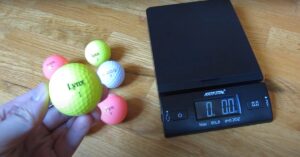How To Read Golf Cart Tire Size?
Are you a golf cart owner baffled by those cryptic numbers on your tires? Fear not! Demystifying the code is easier than you may think.
The key to reading golf cart tire size lies in understanding three specific measurements: diameter, width, and height. These figures give an accurate representation of your tire’s dimensions.
Stick around as we break down these measurements in simple terms. By the end of our discussion, you’ll be fluent in ‘tire-talk’, ready to make informed decisions for your beloved golf cart!
Key Takeaways
- Understand the basics: Golf cart tire size is determined by a combination of numbers and letters, which indicate important specifications such as width, aspect ratio, and rim diameter.
- Deciphering the code: The first number represents the tire’s width in inches, followed by a slash (/) that separates it from the aspect ratio – a percentage indicating the tire’s height relative to its width.
- Pay attention to load capacity: The load index, usually represented by two or three digits after the aspect ratio, indicates how much weight each tire can support.
- Match your rims correctly: The final part of the code refers to the rim diameter in inches; ensure you select tires with matching rim sizes for optimal performance and safety on your golf
Determine the Importance of Golf Cart Tire Size
When it comes to golf carts, tire size may not be the first thing that comes to mind. However, it plays a crucial role in determining the performance and safety of your cart. Let’s dig deeper into why golf cart tire size is important and how it can impact your overall experience on the course.
1. Traction and Stability: The size of your golf cart tires directly affects its traction and stability on different terrains. Larger tires provide better grip, especially on uneven or hilly courses, reducing the chances of skidding or sliding during turns.
2. Ground Clearance: Another aspect influenced by tire size is ground clearance. Smaller tires may cause your golf cart to scrape against obstacles or potentially damage the undercarriage when traversing rough terrain or bumps. Opting for larger tires ensures sufficient clearance and protects your cart from unnecessary wear and tear.
3. Speed and Efficiency: Tire circumference impacts speed as well as battery life efficiency. Bigger tires cover more distance with each revolution, allowing you to achieve higher speeds without overtaxing the motor or draining batteries quickly.
4. Smooth Ride: The right tire size contributes to a smoother ride by absorbing shocks and vibrations caused by bumps or imperfections on the course surface. This not only enhances comfort but also reduces strain on both you and your vehicle.
By assessing these factors, you can determine which tire size best suits your needs based on terrain conditions, desired speed range, maneuverability requirements, and personal preferences.
How to Decipher the Numbers and Letters on Golf Cart Tires
If you’ve ever taken a close look at your golf cart tires, you may have noticed a series of numbers and letters imprinted on the sidewall. While it may seem like a random jumble of characters, these markings actually provide valuable information about your tires. So, let’s find out how to decipher these numbers and letters to gain a better understanding of your golf cart tires.
The first thing to note is that the tire size is typically indicated by three sets of numbers separated by slashes. For example, you might see something like 18/8.50-8 or 205/65-10. The first number represents the height of the tire in inches or millimeters, while the second number denotes the width of the tire in inches or millimeters. The third number indicates the diameter of the wheel in inches.
Another important aspect to consider is load capacity. This information can be found after the tire size designation and is represented by a letter such as B, C, D, or E. Each letter corresponds to a specific load rating ranging from light-duty (B) to heavy-duty (E). It’s essential to choose tires with an appropriate load rating for your specific golf cart model and usage requirements.
Additionally, you may come across speed ratings denoted by letters such as J, K, L, M, N, P or Q after the load capacity designation. These letters indicate how fast it’s safe to drive with those particular tires installed on your golf cart.
By understanding these key elements encoded within those seemingly cryptic numbers and letters on your golf cart tires’ sidewalls, you can ensure that you make informed decisions when purchasing new ones for replacement or upgrading purposes.
Factors to Consider When Choosing the Right Tire Size for Your Golf Cart
Choosing the right tire size for your golf cart is crucial in ensuring optimal performance and safety on the course. The size of your tires can impact various aspects such as speed, traction, stability, and overall comfort during your rounds. Let’s explore some key factors that you should consider when making this important decision.
Terrain
Assessing the terrain where you will primarily be using your golf cart is essential. Different tire sizes are designed to perform better on specific terrains. For example, if you often play on hilly or uneven courses, larger tires with deeper treads may provide better traction and stability.
Speed
The desired speed of your golf cart also plays a role in determining the appropriate tire size. If you prefer a faster pace, smaller diameter tires can increase top speed by reducing rotational resistance. On the other hand, larger diameter tires offer more stability at higher speeds but may sacrifice acceleration.
Clearance
It’s important to consider whether your chosen tire size will affect ground clearance or interfere with other components of your golf cart. Ensure that there is ample space between the tires and wheel wells to prevent rubbing or potential damage while navigating uneven surfaces.
Load Capacity
Take into account how much weight your golf cart will typically carry – including passengers and equipment – when selecting tire size options. Tires with higher load ratings are recommended for carts carrying heavier loads to maintain proper handling and prevent premature wear.
Aesthetics
While not directly related to performance, many golf cart owners also prioritize aesthetics when choosing their tire size. Consider how different sizes may complement the overall look of your vehicle and align with personal preferences.
Tips for Properly Measuring and Comparing Golf Cart Tire Sizes
When it comes to golf cart tire sizes, getting the right measurements is crucial. But with so many options available, how do you know which size is best for your cart? Don’t worry, we’ve got you covered! In this section, we will provide you with some valuable tips to help you properly measure and compare golf cart tire sizes.
1. Measure the diameter:
The first step in determining the right tire size for your golf cart is measuring its diameter. To do this, simply take a tape measure or ruler and measure from one side of the tire’s outer edge to the other side. Make sure to include any tread on the tire when taking your measurement.
2. Check the width:
Next, you’ll need to determine the width of your current tires or desired replacement tires. This can be done by measuring across the widest part of the tire from sidewall to sidewall.
3. Consider aspect ratio:
Another important factor to consider when comparing golf cart tire sizes is the aspect ratio. This refers to the height of the sidewall as a percentage of its width. A lower aspect ratio means a shorter sidewall and vice versa.
4. Verify bolt pattern:
Before making any final decisions on new tires for your golf cart, make sure that they have a compatible bolt pattern with your wheels. The bolt pattern represents how many bolts are used to secure each wheel onto your axle hub.
By following these tips and considering all aspects mentioned above, you can ensure that you choose appropriate-sized tires for your golf cart that will provide optimal performance on various terrains while maintaining safety standards.
Understanding the Impact of Incorrect Tire Sizes on Performance and Safety
Incorrect tire sizes can have a significant impact on both the performance and safety of your vehicle. Let’s explore why this is the case.
Handling and Stability
The size of your tires directly affects how your vehicle handles and maintains stability on the road. When you use incorrect tire sizes, it can lead to poor handling, reduced grip, and compromised stability during turns or sudden maneuvers.
Braking Distance
Your braking distance can be affected by using incorrect tire sizes. Tires that are too small may not provide enough traction to stop your vehicle efficiently, while oversized tires can increase stopping distances due to added weight and reduced contact with the road surface.
Fuel Efficiency
Using improper tire sizes can also impact fuel efficiency. Larger tires often result in increased rolling resistance, requiring more energy from your engine to maintain speed. This extra strain can lead to decreased fuel economy over time.
Suspension Wear
Incorrectly sized tires put additional stress on your suspension system as they may not properly absorb shocks from bumps or uneven surfaces. This increased wear and tear could result in premature damage to suspension components, leading to costly repairs.
Tire Longevity
In addition to affecting other areas of performance and safety, using incorrect tire sizes can significantly reduce their lifespan . Misaligned wheels or excessive wear caused by improper fitment will cause you needing new tires sooner than expected .
FAQs
Q: What do the numbers on a golf cart tire represent?
A: The numbers on a golf cart tire represent its size. The first number indicates the height of the tire, while the second number represents the width.
Q: How can I determine if a golf cart tire is compatible with my vehicle?
A: To determine compatibility, you need to match the tire size specified by your golf cart manufacturer. This information can usually be found in your owner’s manual or by contacting the manufacturer directly.
Q: What does the letter at the end of a golf cart tire size indicate?
A: The letter at the end of a golf cart tire size signifies its construction type. For example, “R” stands for radial construction, which is commonly used in modern tires.
Q: Can I use different-sized tires on my golf cart?
A: It is generally recommended to use tires that are all the same size on your golf cart for optimal performance and safety. Mixing different-sized tires may affect handling and stability.




